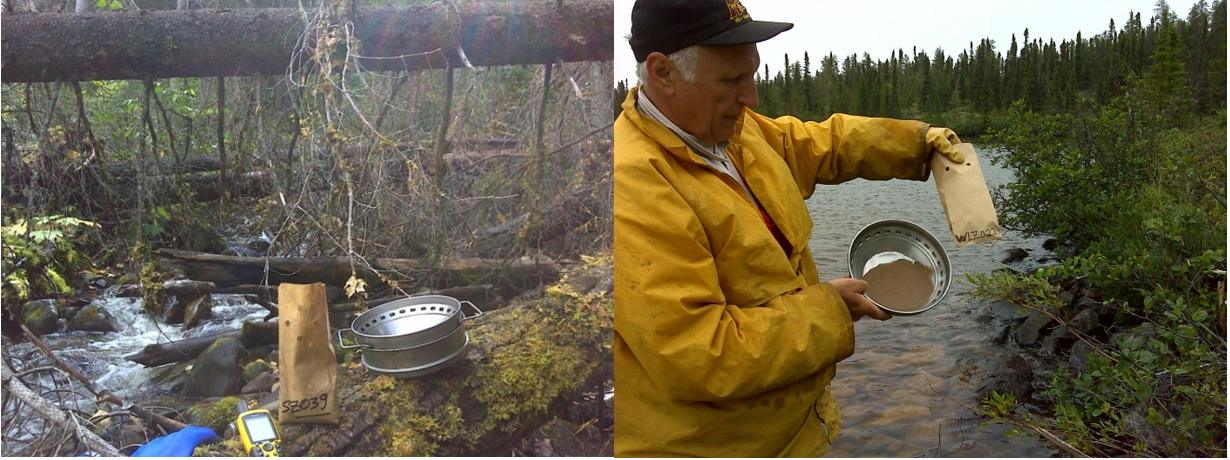The commonly practiced collection of stream sediment samples in mineral exploration, including the Canadian British Columbia (BC) government’s Regional Geochemical Surveys (RGS), is the ‘grab’ method of collecting fine fluvial silt by hand which, in the typical < 80-mesh fraction usually analyzed, almost always includes some organic phase material along with the dominant lithic phase. Though the organic content is determined by loss on ignition, LOI, such as used in the RGS analyses, a high amount of computerization is required to unscramble what portion of an anomalous element present in a single aqua regia-based analysis value is associated with the organic phase, which may be more or less proportionally enriched relative to the lithic phase.
Rather than improving the stream sediment sampling protocol to begin with, a multitude of selective extraction procedures have proliferated (Hall, 1998), and even a continuous leach technique (MacFarlane et al.), in order to unravel ‘true’ from ‘false’ ore element and pathfinder element anomalies present in a multi-phase grab-type sediment (and analogous multi-horizon soil) sample.
Since the early 1980’s, while employed by Falconbridge Nickel Mines as a field geochemist across Canada and in the Caribbean, and subsequently working as a consulting exploration geochemist (e.g. for Cominco International in S. America for base metals, for uranium clients in the Athabasca Basin, and for precious metals clients globally), the writer has been conducting all his geochemical stream sediment sampling surveys using the ‘Barakso’ perforated pan and screen device, sold at the time by its inventor, John Barakso, at his Min-En geochemical laboratory in N. Vancouver, B.C.
With skillful use and experienced sample site selection of fluvial high-energy locations, including midstream moss- and plant root-covered high boulders, or overbank stream sediment traps,
the ingenious pressed-steel perforated pan pictured below collects clean, single-phase wet-sieved fluvial lithic sediment, eliminating seasonal variations and providing much more repeatable analytical values than grab silt sampling does. As the perforated pan is not in commercial production, clean lithic stream sediment can alternatively be isolated with the traditional gold pan by floating off the organics, but stopping the concentration well short of losing the intermediate heavy minerals (HMs), such as goethitic limonites.
The high quality single phase field-sieved ‘Lithic Drainage Sediment’, or the ‘LDS’, sampling method provides reliably interpretable multi-element information in a single aqua regia/ICP-MS < 80-mesh analysis originating both from anomalous detrital dispersion of weathered outcrop and subcropping mineralization and from anomalous chemical, or hydromorphic dispersion originating from completely blind oxidizing base- or precious-metals mineralization, as described in (Laville-Timsit et al.,1989): Chemical dispersion processes play a dominant role in creating geochemical anomalies over blind orebodies, a fundamental difference from the detrital origin of anomalies derived from near-surface deposits. Secondary geochemical dispersion can only be achieved through a sequential process involving weathering and leaching, transport in solution, and final immobilization, possibly at some distance, by processes such as precipitation …
In 1986, the writer provided RGS sample quality control and field supervision on behalf of the GSC (Geological Survey of Canada) and the BCMEMPR for the Whitesail and Smithers Map Sheets, 93E and 93L, in north-central BC, and concurrently conducted an LDS method field-sieved stream sediment sampling survey as a contribution on the importance of sample quality in conducting geochemical drainage sampling surveys (Zastavnikovich, 1987), as a follow-up to a previous RGS zinc anomaly, and its HM follow-up in the Blackwater Mountain area on Map Sheet 93G/2 (Boronowski, 1986). Unlike the traditional HM stream sediment sampling, which resulted in some very high, but haphazardly distributed gold values, the writer’s wet-sieved LDS method follow-up sampling provided uniformly distributed interpretable precious metal and pathfinder element values that helped distinguish between placer-sourced and lode-sourced gold anomalies, and as well identified the hydromorphic nature of the original RGS zinc anomaly.
Photos 1,2. The perforated ‘Barakso’ pan and sieve device used in the LDS sampling method
In the LDS sampling surveys, the samples are quickly wet-sieved onsite using a 20- or 40-mesh screen or, when helicopter-supported, can be quickly shovel-bagged and wet-sieved or panned at a central location. Where the low added processing and analytical cost is justified, such as in initial reconnaissance stream sediment sampling, the writer has used magnetic separation to advantage to obtain further sample quality enhancement, and correspondence to mineralized rock lithochemistry. The LDS sampling method provides dependable analytical results, which in turn allow subtle statistical differentiation based on major, minor and trace element correlation and inflection points on individual element frequency distribution graphs, leading to enhanced geochemical interpretation of the sampled area’s ‘true’ anomalies and its mineralization potential.
As a standard exploration procedure, the most important LDS reconnaissance-scale identified anomaly areas, whether detrital or hydromorphic, can then be followed-up by additional geochemical and geophysical methods, focusing significant expenditures first on the geochemically most prospective sectors of any mineral exploration property.
Sam Zastavnikovich, P. Geo.,
tel. 604-946-8785;
5063-56th St., Delta, B.C., Canada, V4K3C3
Consulting Geochemist,
e-mail. sam.zast@telus.net
REFERENCES
Boronowski, A.J., 1986. 1985 Orientation Survey, Follow Up of Two 1984 Regional Geochemical Survey Geochemically Anomalous Drainages by Panned Stream Sediment and Silt Sampling, Blackwater Mtn. Area (93G/2) and Clear Mtn. Area (93H/6). BCMEMPR, Geological Fieldwork, 1985, Paper 1986-1, p. 115-120.
Hall, G.E.M., 1998. Analytical perspective on trace element species of interest in exploration. Journal of Geochemical Exploration, V. 61, p. 1-19.
Laville-Timsit, L., Wilhelm, E., 1989. An attempt for selectively using the chemical dispersion of metals to search for hidden deposits. Journal of Geochemical Exploration, V. 32, p. 243-256.
MacFarlane, W.R., Kyser, T.K., D. Chipley, D. Beauchemin, C. Oates, 2005. Continuous leach inductively coupled plasma mass spectrometry: applications for exploration and environmental geochemistry. Geochemistry: Exploration, Environment, Analysis, V. 5, p. 123–134.
Zastavnikovich, S., 1987. Geochemical Follow-up of RGS Data Report On The Field-Sieved Stream Sediment Sampling Method, Blackwater Mtn. Area. BCMEMPR,Geological Fieldwork 1986, Paper 1987-1, p.405-410.

